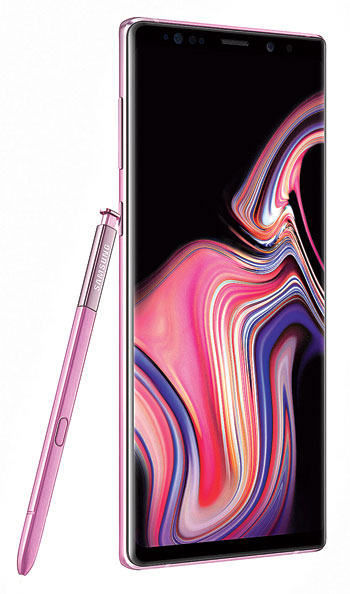
Samsung Galaxy Note9
Price: Rs 67,900 onwards
Samsung’s big-screen blockbuster from last year is back, this time packing more screen, more battery, more power and a feature-packed S Pen stylus with a couple of new tricks up its sleeve.
That display, a 6.4-inch Super AMOLED number, is simply gorgeous and without parallel in the phone business. The colours are punchy, blacks are inky and photos and videos (and practically any content) keep reminding you of just how worthwhile your purchase has been! The S Pen continues to do well what we’ve loved it for all these years — writing memos, navigating the interface and drawing on the screen — but this time around, it has Bluetooth support for launching and controlling apps. You can, for instance, use it to change slides in PowerPoint or as a remote shutter release when taking a group selfie. Added bonus: it slides in and recharges in about 40 seconds! The hardware, whether it is the Exynos 9810 chip or the dual-aperture camera setup, both of which we’ve seen previously in the S9+, is a delight, and if you’re willing to pay a little bit extra, you can pick up the 8GB/512GB version which is a performance monster. Luckily, the 4,000mAh battery is a return to form for Samsung, so you no longer have to compromise all-day longevity for all this performance.
The design is iterative, so unless you’re looking closely (primarily at the fingerprint scanner which has now moved below the cameras instead of alongside), you won’t be able to tell this generation apart from the last one. That’s not a bad decision, per se — the metal and glass signature design is refined and premium, just nothing new to look at. Form factor is still unwieldy for most hands. Ships with Android 8.1 Oreo, so it behaves much like the previous gen Note 8, software wise.

Poco F1
Price: Rs 20,999 onwards
Launching a new sub-brand (Poco) allows Xiaomi to rewrite the rules without the baggage of existing product lines, and boy, does the F1 do that and more! Packing a top-shelf Snapdragon 845 chip, speedy LPDDR4X RAM and UFS 2.1 storage (notice the focus on speed, ergo F1?) in three memory/storage variants, all of which retail for under Rs 30,000, the Poco F1 offers unmatched value and makes some flagship killers look overpriced in comparison! Earns an easy recommendation, if you can manage to snag one in a flash sale.
The F1 surprises in just how many boxes it checks off with no obvious compromises and is a testament to what Poco can deliver with a little help from Xiaomi’s scale. A sharp and bright 6.18-inch 19:9-aspect ratio IPS LCD panel makes a great first impression, and the notch in the display actual manages to house iPhone X-style infrared facial recognition feature which works equally fast in the dark. The flagship-grade internals are mated to a liquid cooling system, which prevents overheating (and consequently, throttled performance) during prolonged gaming sessions. The battery is a capacious 4,000mAh, plus it offers QuickCharge support with a fast charger in the box (for a change!). The F1 uses a Poco variant of MIUI 9.6 which not only is super snappy but offers a host of customisations (including a much-needed app drawer). The cameras fare well for their price category, with images showing good details and high dynamic range, but softening images a tad in low light.
Going with a polycarbonate rear panel gives the F1 a durable build that glass backs can’t match (no case needed!). The downside is that the phone doesn’t look as premium. That said, there are blue, red and black colour options, and the super distinctive Kevlar-back Armored Edition (Rs 29,999) if you’re open to splurging a little bit. Teething issues (in some apps) will hopefully be fixed in software in the near future

Apple MacBook Pro 15 (2018)
Price: Rs 1,99,900 onwards
Apple’s flagship MacBook Pro laptops have been held in high regard by professionals for the longest time, but of late had fallen behind just as Windows portables upped their game. The 2018 refresh atones for its recent missteps, bumping up the internals to serve up the latest Intel processors along with more memory and storage options to win back favour with their core ‘Pro’ audience.
It may look no different from last year’s 15-inch model, and the display is gorgeous as ever, only this time around, the stunningly-detailed display sports the True Tone tech we’ve previously seen on the iPad Pro. What this does is reduce eye strain by matching the brightness and colour temperature to the ambient light available, although professional users who need to work with accurate colour reproduction can turn this feature off if needed. The big changes are under the covers, with the move to the latest eighth-generation Intel processors giving each model a bump up in processor cores and better graphics, not to mention a big upgrade in terms of memory. Our test unit, a Core i9/32GB RAM/2TB storage option that is yet to retail in India, was a beast during intensive activities like editing multiple 4K video streams, but even the more modest (in comparison) Core i7-based models will impress with the amount of raw power during everyday use. Folks with heavy graphics needs will appreciate the powerful AMD Radeon Pro 555X/560X graphics and the faster RAM chips. Despite all this added power, the battery life still delivers a respectable 10 hours on a single charge, courtesy a larger capacity battery this time around.
Apple has retained the design and distinctive form factor of the MacBook Pro, which means that while it still manages the incredible feat of packing in a 15.4-inch display in a 1.8kg package, it’s still devoid of the regular ports and the more comfortable keyboard of the previous generation of Pros. You get four USB-C ports, but the SD card slot and a full-sized USB port are still missed. The keys now have a silicone cover under each key, so it’s softer to the ear and the finger and should also address the issue of dust jamming up the keys.
Tushar Kanwar is a tech columnist and commentator. Follow him onTwitter @2shar. Mail your tech queries to t2onsunday@abp.in











